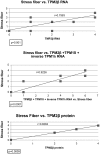Expression of tropomyosin 2 gene isoforms in human breast cancer cell lines
- PMID: 27108600
- PMCID: PMC4869935
- DOI: 10.3892/or.2016.4732
Expression of tropomyosin 2 gene isoforms in human breast cancer cell lines
Abstract
In humans, four tropomyosin genes (TPM1, TPM2, TPM3, and TPM4) are known to produce a multitude of isoforms via alternate splicing and/or using alternate promoters. Expression of tropomyosin has been shown to be modulated at both the transcription and the translational levels. Tropomyosins are known to make up some of the stress fibers of human epithelial cells and differences in their expression has been demonstrated in malignant breast epithelial cell lines compared to 'normal' breast cell lines. We have recently reported the expression of four novel TPM1 isoforms (TPM1λ, TPM1µ, TPM1ν, and TPM1ξ) from human malignant tumor breast cell lines that are not expressed in adult and fetal cardiac tissue. Also, we evaluated their expression in relation to the stress fiber formation. In this study, nine malignant breast epithelial cell lines and three 'normal' breast cell lines were examined for stress fiber formation and expression of tropomyosin 2 (TPM2) isoform-specific RNAs and proteins. Stress fiber formation was assessed by immunofluorescence using Leica AF6000 Deconvolution microscope. Stress fiber formation was strong (++++) in the 'normal' cell lines and varied among the malignant cell lines (negative to +++). No new TPM2 gene RNA isoforms were identified, and TPM2β was the most frequently expressed TPM2 RNA and protein isoform. Stress fiber formation positively correlated with TPM2β RNA or protein expression at high, statistically significant degrees. Previously, we had shown that TPM1δ and TPM1λ positively and inversely, respectively, correlated with stress fiber formation. The most powerful predictor of stress fiber formation was the combination of TPM2β RNA, TPM1δ RNA, and the inverse of TPM1λ RNA expression. Our results suggest that the increased expression of TPM1λ and the decreased expression of TPM1δ RNA and TPM2β may lead to decreased stress fiber formation and malignant transformation in human breast epithelial cells.
Figures





References
MeSH terms
Substances
LinkOut - more resources
Full Text Sources
Other Literature Sources
Miscellaneous

